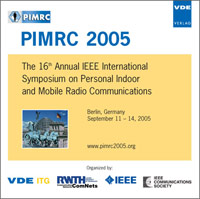Energy Optimized Beacon Transmission Rate in a Wireless Sensor Network
Konferenz: PIMRC 2005 - 16th Annual IEEE International Symposium on Personal Indoor and Mobile Radio Communications
11.09.2005 - 14.09.2005 in Berlin, Germany
Tagungsband: PIMRC 2005
Seiten: 5Sprache: EnglischTyp: PDF
Persönliche VDE-Mitglieder erhalten auf diesen Artikel 10% Rabatt
Autoren:
Kohvakka, Mikko; Hännikäinen, Marko; Hämäläinen, Timo D. (Tampere University of Technology, Institute of Digital and Computer Systems, PO Box 553, 33101 Tampere, Finland)
Inhalt:
Resource constrained Wireless Sensor Networks (WSN) require an energy efficient Medium Access Control (MAC) protocol that minimizes the radio active time (duty cycle). Time slotted MAC schemes provide lowest duty cycles by dividing time into consecutive data exchange and sleep periods. Synchronization for data exchange and network maintenance is achieved by exchanging beacons. For detecting changes in network topology, nodes periodically perform scanning during which beacons are received from neighbors. This is energy consuming, and the energy required equals to the transmission of thousands of packets. This paper shows that the energy consumption is mainly depending on the beacon transmission rate, and that an optimal rate is a function of three parameters: a network scanning interval, beacon transmission energy, and radio reception power. The optimal beacon transmission rate is derived for a TUTWSN prototype by power analysis and energy models. According to the analysis, the optimization decreases the average network energy consumption up to an order of magnitude. For the prototype, the optimal beacon transmission rate is 3.7 Hz, when network scanning is performed with 2 minutes intervals.


